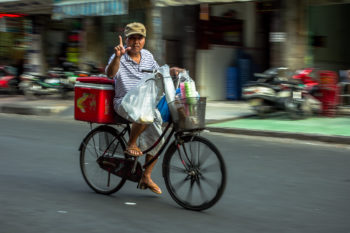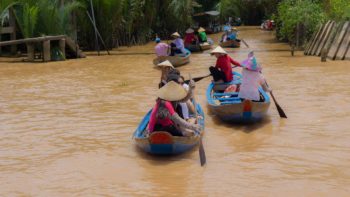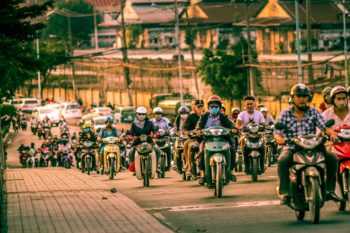Modes of Transportation in Vietnam Posted by Kandle Dart on Feb 22, 2021 in Culture, Transportation, Uncategorized, Vocabulary
Transportation in Vietnam these days has much improved and is very convenient for traveling around the country, thanks to the construction of new roads, expressways, and the availability of cars, buses, airplanes, and motorbikes. Unfortunately, the road traffic has also increased significantly, causing frequent traffic jams, particularly in Hanoi and Ho Chi Minh city.
For long distance travel, the easiest and quickest means is by plane. International and domestic airports are available in all major cities. The three major airports are Nội Bài in the capital Hanoi, Tân Sơn Nhất in Ho Chi Minh City, and Đà Nẵng airport in Da Nang. Domestic plane ticket prices are pretty reasonable, and there are plenty of good regional airports like Dalat and Vinh, served by major carriers.
The cheaper alternative is by train or bus, but it is much slower. A cross country train from Ho Chi Minh City to Hanoi would take between 29-42 hours, by bus it would take between 35-40 hours, while a plane takes around 2 hours.
For short distance, taxis, motorbike taxi, and local buses are widely available in all metropolitan areas. To date, the most common means of daily transportation for the average Vietnamese is still motorbike or bicycle.
For visitors, you can always find places for auto and motorbike rental, if you dare to drive in the chaotic traffic. It is challenging since most people don’t obey traffic laws. I would not recommend it unless you really know how to maneuver like the local way of driving. As a tourist, if you are “down to earth” and want to feel the thrill of the air on a motorbike like the locals on the busy streets, you can take a motorbike taxi. Let a local driver speed you around. It is fast, fun, and very affordable.
For youngsters who are not shy about using current technology, you can utilize mobile transportation apps like Grab or Uber to call for a taxi or motorbike taxi in cities like Hanoi, Da Nang, and Ho Chi Minh.
One unique mode of transportation for tourists who just want to cruise slowly and leisurely around town is a cyclo. Cyclos were once a popular mode of transportation for local residents across the country, dating back to the early 20th century. These days it is used exclusively for tourists in major tourist places. It is one of the icons of classic Vietnam.
Areas with large networks of waterways, particularly the Mekong Delta and Red River Delta areas, ferries, boats, water-taxis are commonly used for transportation. Tourists can take sightseeing tours by boat along Vietnam’s beautiful waterways, which gives a different view of the country.
If you’ve exhausted all other means, do not forget your feet! You can always đi bộ (foot walking). It may cost you some sweat and aches, but it is free, and it sometimes puts you ahead of all other traffic.
Be careful when crossing the street! It is tricky. Observe and follow the locals if you are afraid of crossing. Don’t panic, stay calm, wave your hands, make eye contact with oncoming traffic to ensure they see you, and keep a slow steady pace.
Listed below are a few words about transportation in Vietnam
- Bicycle – Xe đạp
- Cyclo – Xe xích-lô
- Motorbike – Xe gắn máy
- Motorbike Taxi – Xe ôm
- Car – Xe hơi/Xe ô-tô
- Public Bus – Xe buýt
- Airplane – Máy bay
- Airport – Sân bay
- Train – Xe lửa
- Train Station – Nhà ga

Build vocabulary, practice pronunciation, and more with Transparent Language Online. Available anytime, anywhere, on any device.






